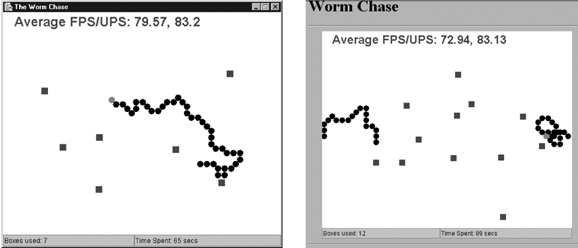Chapter 3. Worms in Windows and Applets
In this chapter, I test the threaded animation loop of Chapter 2 inside a windowed application and an applet. To simplify comparisons between the approaches, the programs are all variants of the same WormChase game. In Chapter 4, I will continue the comparisons, concentrating on several kinds of full-screen applications.
Figure 3-1 shows the windowed WormChase application on the left and the applet version on the right.
 |
The aim of the game is to click the cursor on the red head of the rapidly moving worm. If the player misses the worm’s head, then a blue box is added to the canvas (unless the worm’s black body was clicked upon).
The worm must go around the boxes in its path, so the boxes may make the worm easier to catch. When the worm moves off the top edge of the window it appears at the bottom, and vice versa. When it travels past the left or right edge, it appears at the opposite side. The worm gradually gets longer until it reaches a maximum length, which it maintains for the rest of the game.
When the game finishes, a score is displayed in the center of the window, calculated from the number of boxes used and the time taken to catch the worm. Fewer boxes and less time will produce a higher score. The current time and the number of boxes are displayed below the game canvas in two text fields.
Preliminary ...
Get Killer Game Programming in Java now with the O’Reilly learning platform.
O’Reilly members experience books, live events, courses curated by job role, and more from O’Reilly and nearly 200 top publishers.

